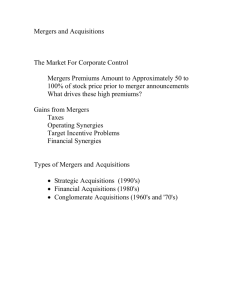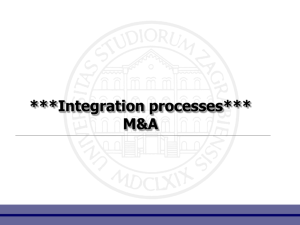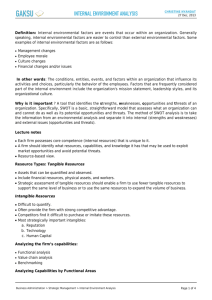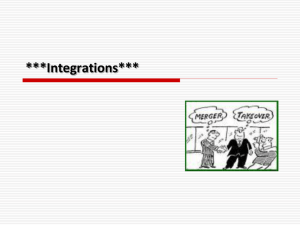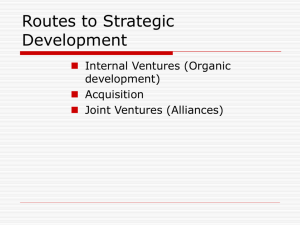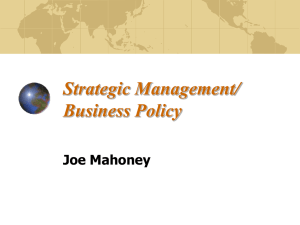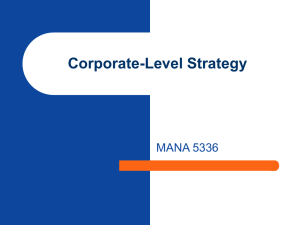Chapter 6&7
advertisement
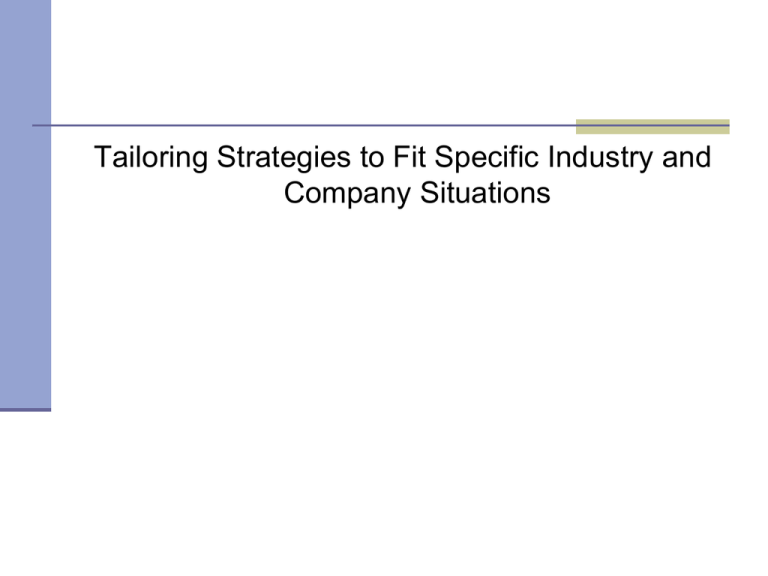
Tailoring Strategies to Fit Specific Industry and Company Situations Life Cycle Unit Sales Profits Life Cycle Emerging Embryonic Introduction Growth Mature Decline Industry Life Cycle Introduction Growth Mature Decline Growth Low Large Lower Negative Segments Few Some Many Few Competition Low Increasing Intense ??? Emphasis V High Prod R&D High Prod V High Process Production Stability Market Awareness Create Demand Functional Objectives Sales & Marketing Defend Share and Extend Admin., mgt. & finance Consolidate Maintain, harvest, or exit Challenges of Emerging Industries • Uncertain market conditions and • • • • • • characteristics Competing/unknown proprietary technologies and varied marketing/service/distribution tactics Lack of complementary products Limited/poor quality and high costs, which deter acceptance Low entry barriers Education of users Innovators vs. Initial adopters vs. Mass-market. Alternatives in Emerging Industry • Move fast/early with superior product or • • • • technology Track the Dominant Design Build alliances/merge with key suppliers or those that provide complementary products to out position rivals Seek new customer groups, new applications for your product Make it cheap/easy for early adopters to try/buy your product. High Technology Industries Battle over technical standard, format, and dominant design Set by decree, cooperation, public domain, but mostly through consumer choices Benefits for Standards Compatibility Reduce consumer uncertainty Reduce production costs Increase in complementary products – Network effects – which greatly enhances sustainability Challenges of Mature Industries • Slow growth fight for market share • Sophisticated buyers • Costs, prices and service critical • Excess capacity and oversupply • Innovation and new uses more difficult • International competition • Falling profitability • Consolidation • Segmentation. Alternatives in Mature Industries • Prune product line • Process innovation & cost reductions in value chain • Sell more to current buyers • Purchase rivals at low prices • Go international. Fragmented Industries Low entry barriers Lack of economies of scale High segmentation Local Advantages Diverse preferences Alternatives in Fragmented Industries • Formula facilities • Low cost operations • Become the specialized vendor of choice • Focus on a customer type • Focus on a geographic segment - Other Runner-up Strategies • Vacant Niche Strategy • Specialists Strategy • Superior Products Strategy • Distinctive Image Strategy • Content Follower – Strategic Management Part II: Strategic Actions: Strategy Formulation Chapter 6: Corporate-Level Strategy 14 Corporate-level strategy Specifies actions a firm takes to gain a competitive advantage by selecting and managing a group of different businesses competing in different product markets Expected to help firm earn above-average returns Value ultimately determined by degree to which “the businesses in the portfolio are worth more under the management of the company then they would be under any other ownership Product diversification (PD): primary form of corporate-level strategy 15 Goals of Corporate Strategy Moves to enter new businesses Boosting combined performance of the businesses Capturing synergies and turning them into competitive advantages Establishing investment priorities and steering resources into business units 4 Conditions of Successful Diversification • 1) Growing industries with complementary products and technologies • Apple IPhone • 2) Leverage existing capabilities which match the KSFs in other arenas • Disney Cruise Lines • 3) Closely related moves which reduce costs • Kroger & Fred Meyer • 4) Powerful brand and reputation • Margueritaville, NASCAR Café, or Emril’s Levels of Diversification (N=3) 1. Low Levels Single Business Strategy Corporate-level strategy in which the firm generates 95% or more of its sales revenue from its core business area Dominant Business Diversification Strategy Corporate-level strategy whereby firm generates 70-95% of total sales revenue within a single business area 18 Levels of Diversification (N=3) (Cont’d) 2. Moderate to High Levels Related Constrained Diversification Strategy Less than 70% of revenue comes from the dominant business Direct links (I.e., share products, technology and distribution linkages) between the firm's businesses Related Linked Diversification Strategy (Mixed related and unrelated) Less than 70% of revenue comes from the dominant business Mixed: Linked firms sharing fewer resources and assets among their businesses (compared with related constrained, above), concentrating on the transfer of knowledge and competencies 19 among the businesses Levels of Diversification (N=3 ) (Cont’d) 3. Very High Levels: Unrelated Less than 70% of revenue comes from dominant business No relationships between businesses 20 Drawbacks for Unrelated Demanding requirements Limited to no opportunities to share advantages Levels and Types of Diversification 22 Strategic Management: Concepts and Cases Part II: Strategic Actions: Strategy Formulation Chapter 7: Acquisition and Restructuring Strategies 23 Cross-Border Acquisitions: Increased Trend Number of cross-border deals continues to increase in all corners of the world Acquisitions by emerging-country firms occurring in developed countries, especially in the U.S., UK and Europe Developed economies have more open policies allowing emerging-country economies to make inroads, especially in more mature businesses including steel, aluminum and cement; or basic services such as management of airports and railroads, or infrastructure management, such as toll roads 24 Introduction: Popularity of M&A Strategies Popular strategy among U.S. firms for many years Can be used because of uncertainty in the competitive landscape Increase market power because of competitive threat Spread risk due to uncertain environment Shift core business into different markets Due to industry or regularity changes Intent: increase firm’s strategic competitiveness and value – the reality, however, is returns are close to zero 25 Introduction: Merger vs. Acquisition vs. Takeover (Cont’d) Merger Two firms agree to integrate their operations on a relatively co-equal basis Acquisition One firm buys a controlling, 100 percent interest in another firm with the intent of making the acquired firm a subsidiary business within its portfolio. Takeover Special type of acquisition strategy wherein the target firm did not solicit the acquiring firm's bid Hostile Takeover: Unfriendly takeover that is unexpected and undesired by the target firm 26 Mergers and Acquisitions Reasons of Acquisitions Market Power Overcome Entry Barriers Increased Speed Lower Risk New Technologies/Capabilities Diversify Gain Competitive Advantages Mergers and Acquisitions Problems with Acquisitions Integration of two firms Overpayment/Debt Overestimation of Synergy Overdiversification Managerial energy absorption Become too large Substitute for innovation Inadequate evaluation Mergers and Acquisitions Results Poor Performance Who Wins? Acquired Firm Shareholders Failures of Acquisitions 30 - 40% average acquisition premium Acquiring firm’s value drops 4% in the 3 months following acquisitions 30 - 50% of acquisitions are later divested Acquirers underperform S&P by 14%, peers by 4% 3 month performance before and after 30% substantial losses, 20% some losses, 33% marginal returns, 17% substantial returns The Curvilinear Relationship between Diversification and Performance 31 Why, then, do executives acquire? Often, for personal reasons Firm size and executive compensation are related When do executives loss their jobs? 1) Acquired - larger firms harder to acquire 2) Performing poorly - employment risk is reduced as returns are less volatile Effective Acquisitions Complementary assets or resources Friendly acquisitions facilitate integration of firms Effective due-diligence process (assessment of target firm by acquirer, such as books, culture, etc.) Financial slack Low debt position High debt can… Increase the likelihood of bankruptcy Lead to a downgrade in the firm’s credit rating Preclude needed investment in activities that contribute to the firm’s long-term success Innovation 33 Flexibility and adaptability When/Why to Diversify? To create shareholder value Porter’s Three Point Test 1) Attractiveness Test 2) Cost of Entry Test 3) Better off Test Should pass all 3


